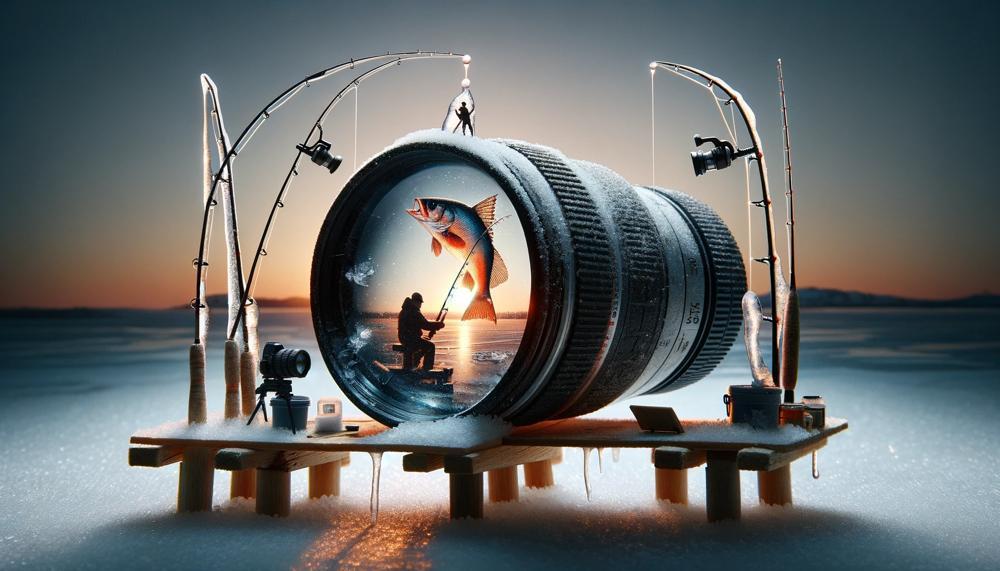Have you ever pondered the reason behind the minuscule size of ice fishing rods in comparison to their traditional counterparts?
Despite their petite stature, these rods play a significant role in the success of ice fishing.
Join us as we delve into the intricacies of why ice fishing rods are designed to be small and how it impacts the overall fishing experience.
From specialized features to the materials used, there is more than meets the eye when it comes to these tiny but mighty tools.
So, grab a warm mug of cocoa and join us on this journey through the fascinating world of ice fishing rods.
Ever Wonder Why Ice Fishing Rods Are So Small?
Contents
Ice fishing rods are usually smaller than regular fishing rods because they are tailored for the unique conditions of ice fishing. The smaller size assists with sensing fish bites, which can be more challenging in colder temperatures.
Furthermore, utilizing a regular-sized rod for ice fishing may require different techniques, which may not be as effective as jigging or tip-up fishing.
On top of that, the compact size of ice fishing rods also makes them more convenient for use inside small shelters and for targeting smaller fish.
However, it’s essential to select an ice fishing rod that matches the species being pursued and consider factors such as material and length. Ultimately, the size and design of ice fishing rods allow for better control when reeling in fish through an ice hole and make them more suitable for the specific conditions of ice fishing.
Did you know that the shorter length also allows for increased sensitivity? This means anglers can feel even the slightest nibbles from fish, making it easier to detect when a fish is biting. And in the world of ice fishing where fish can be scarce and bites can be subtle, this can make all the difference.
In addition, the smaller size of ice fishing rods makes them easier to maneuver and use in tight spaces. Imagine trying to navigate a large, bulky rod inside a small ice shelter – it’s not exactly ideal. But with a compact rod specifically designed for ice fishing, anglers can easily move around and target their desired spot without any hassle.
So, there you have it – now you know why ice fishing rods are smaller than regular fishing rods. Not only do they provide better control and sensitivity, but they also offer practicality and convenience in the unique conditions of ice fishing.
Why So Small?
When fishing through the ice, the rods are usually not as big as standard poles. This is because of many things, including the fact that ice fishing is different, the fish that are usually caught, the very cold weather, sensitivity, and flexibility.
Ice fishing is different from other types of fishing because fishermen have to cut holes in thick layers of ice and wait for fish to pass by. To do this, you need different skills and methods, which is why you need special tools like shorter rods.
If you go ice fishing, you’re probably going to catch smaller fish than if you went open water fishing. So, when you’re bringing in these smaller fish, using a smaller rod gives you more accuracy and control.
When it comes to ice fishing tools, extreme temperatures are also very important. Cold weather can ruin traditional fishing poles, making them less durable and useful. Smaller ice fishing sticks, on the other hand, are made to work well in these harsh circumstances.
Also, being sensitive is very important when ice fishing. Because it’s hard to see through the thick layer of ice, anglers depend on how sensitive their lines are to feel any movement or bites from fish. It is best to use smaller rods for this type of fishing because they are more sensitive.
Finally, the smaller size of ice fishing sticks is due to the fact that they are easier to carry. It can be hard and tiring to carry big things over thick layers of ice. Anglers can move around and find the best spot for their next catch more easily when they use small, light lines.
Do You Really Need a Small Rod For Ice Fishing?
Small rods can be good for ice fishing if you plan on catching panfish or perch. They are light and don’t take up much space.
Ice fishing rods are typically shorter, more flexible, and better at handling freezing conditions than regular fishing rods. They are usually 24–36 inches long, made of graphite or fiberglass, and have a solid backbone in the lower two-thirds.
The length of the rod you need depends on the type of bite you’re getting:
- Shorter rods: Better for finesse biting and sight fishing over a hole
- Longer rods: Better for fighting bigger fish and being outside in the elements
You can also use a regular fishing rod for ice fishing. If you want to use a spinning rod, any traditional ice fishing spinning rod will work with an inline reel.
Best Length for An Ice Fishing Rod
The most suitable length for an ice fishing rod is around -7 inches, and there are multiple reasons why this specific length is crucial for a successful ice fishing experience.

- Versatility: A -7” ice fishing rod offers versatility for various types of ice fishing. It allows you to target a wide range of fish species and gives you the freedom to use different techniques.
- Space-saving: Space can be limited when ice fishing in small huts or crowded lakes. A -7” rod is compact and takes up minimal space, making it easier to maneuver and fish comfortably.
- Sensitivity: A shorter rod has less flexibility, resulting in increased sensitivity to subtle bites. This is especially beneficial when targeting smaller or finicky fish species.
- Strength: Despite its shorter length, a -7” ice fishing rod still has enough backbone to handle larger fish, making it a great all-around option for various sizes of fish.
Advantages of a -7” Ice Fishing Rod
- Detect Subtle Bites: As mentioned, the shorter length of a -7” rod allows for enhanced sensitivity, making it easier to detect even the slightest bites. This can be crucial when targeting trickier fish species.
- Improved Control: A shorter rod provides better control over your line and allows for more precise movements while fishing. This can be advantageous when dealing with icy conditions or trying to reel in a fighting fish.
- Enhanced Accuracy: With a shorter rod, you have better accuracy when casting and setting the hook, resulting in more successful catches.
- Comfortable Fishing: The compact size of a -7” ice fishing rod makes it more manageable and comfortable to fish with for extended periods.
Can Small Ice Rods Handle Big Fish
Small ice fishing rods are a good option because they are light and don’t take up much space. However, they are not ideal for catching fish larger than perch or panfish.
Larger ice fishing rods are better for hooking large fish, but they may be more difficult to transport.
Tips for Choosing an Ice Fishing Rod
When faced with the task of selecting an ice fishing rod, there are several pivotal factors that must be taken into consideration. These include the length and power of the rod, its material composition, action, handle, reel seat, line guides, and portability.
Each of these elements plays a critical role in determining the effectiveness and suitability of an ice fishing rod for a particular angler and situation. Let’s delve deeper into each factor.
Length and Power:
The length and power of an ice fishing rod are crucial in determining the type of fish that can be caught and the techniques that can be used. Shorter rods ranging from 24-30 inches are best suited for smaller fish such as panfish, while longer rods ranging from 36-42 inches are more appropriate for larger fish like pike and lake trout.
As for power, a light power rod is suitable for small fish, while a medium to heavy power rod is better equipped to handle larger and more aggressive fish.
Material:
Typically, ice fishing rods are constructed using either fiberglass or graphite. Fiberglass rods are known for their durability and ability to withstand harsh weather conditions. However, they tend to be heavier and less sensitive compared to graphite rods.
On the other hand, graphite rods are lighter and more sensitive, making them ideal for detecting even the slightest nibble from a fish. However, they may be more susceptible to breaking in extreme cold temperatures.
Action:
The action of an ice fishing rod refers to how much it bends when pressure is applied to the tip. Fast action rods bend mostly at the tip, while slow action rods bend throughout their length. Fast action rods are known for their sensitivity and provide quicker hook sets, making them ideal for jigging small lures.
On the other hand, slow action rods are better suited for bigger baits and larger fish that require a more gradual hook set.
Handle:
The handle of an ice fishing rod should be comfortable and provide a good grip, particularly in cold and wet conditions. Handles can be made of cork, foam, or rubber, each with their own unique benefits. Cork handles offer a traditional and natural feel, but they can become slippery when wet.
Foam handles provide a better grip and are more durable, while rubber handles offer the best grip in wet conditions.
Reel Seat:
The reel seat is where the reel is attached to the rod. When selecting an ice fishing rod, it is important to ensure that the reel seat is sturdy enough to withstand cold temperatures and heavy fish. Look for metal or carbon fiber seats rather than plastic ones.
Line Guides:
Line guides are the small circles along the rod that guide the fishing line. They should be smooth and evenly spaced to prevent tangles and allow for smooth casting.
Stainless steel or ceramic guides are recommended for ice fishing rods as they can withstand extreme temperatures.
Portability:
Since ice fishing involves traveling to different locations on the frozen lake, portability is a crucial factor to consider when choosing an ice fishing rod.
Conclusion
In summary, the seemingly small size of ice fishing rods may be perplexing to some, but it actually serves a vital purpose in this specialized sport.
These compact rods offer increased sensitivity and control, making them perfect for maneuvering in the unique conditions of ice fishing. Additionally, their portability allows for easy transportation and setup on the frozen lake.
Whether you’re after smaller panfish or larger species, there is a suitable ice fishing rod to meet every angler’s preferences and goals.






